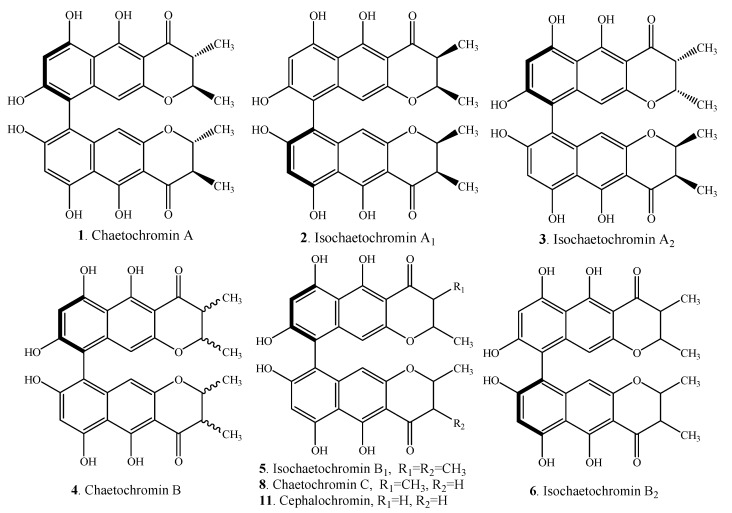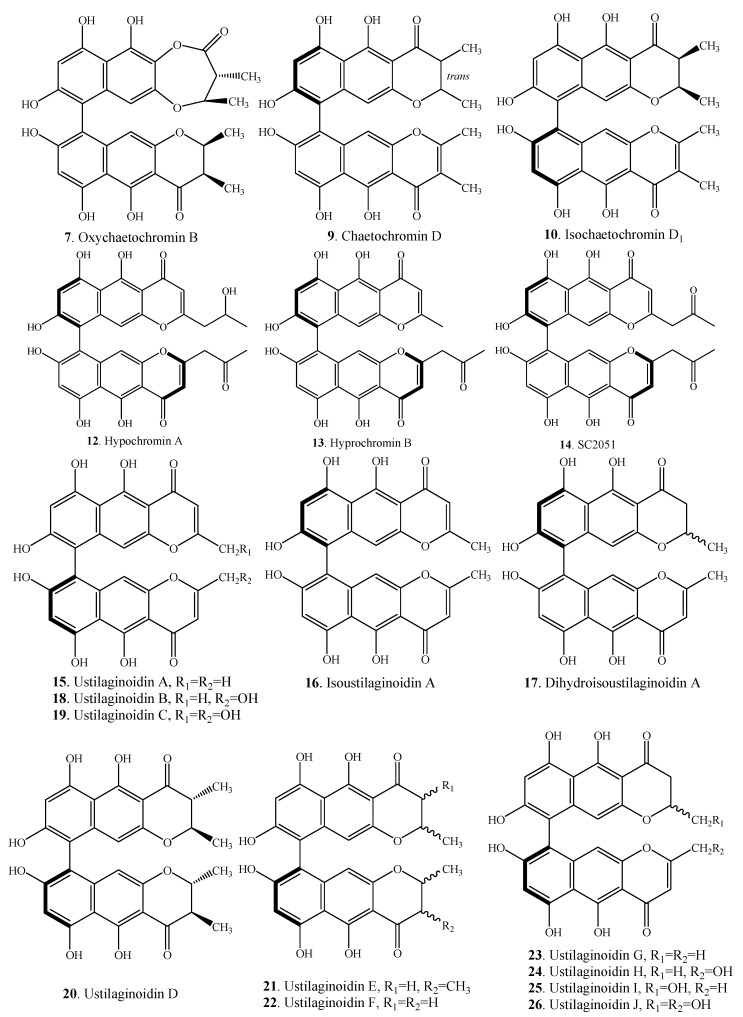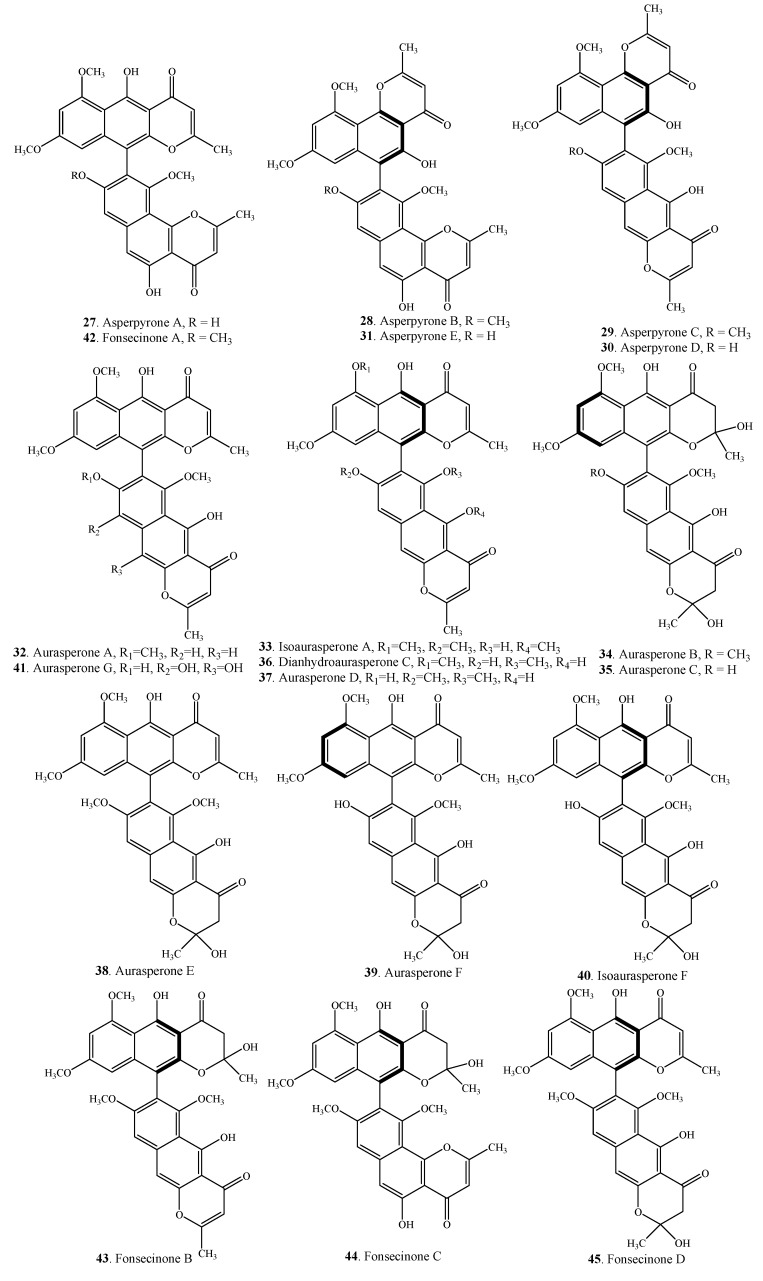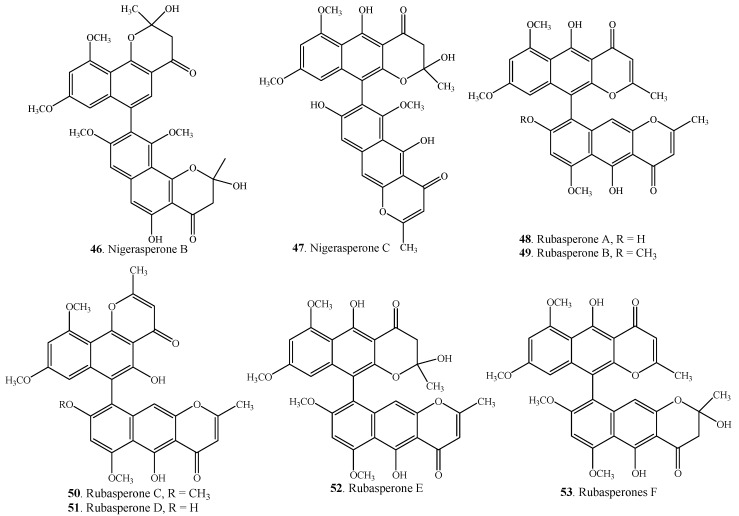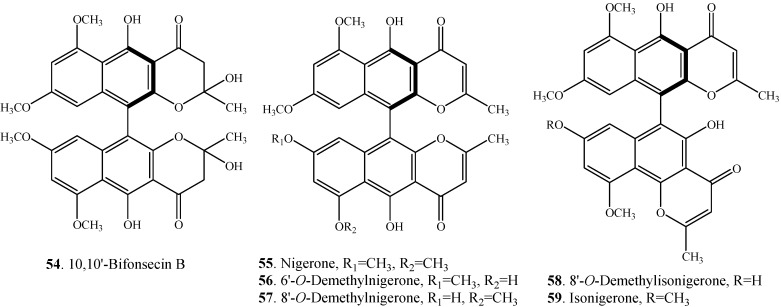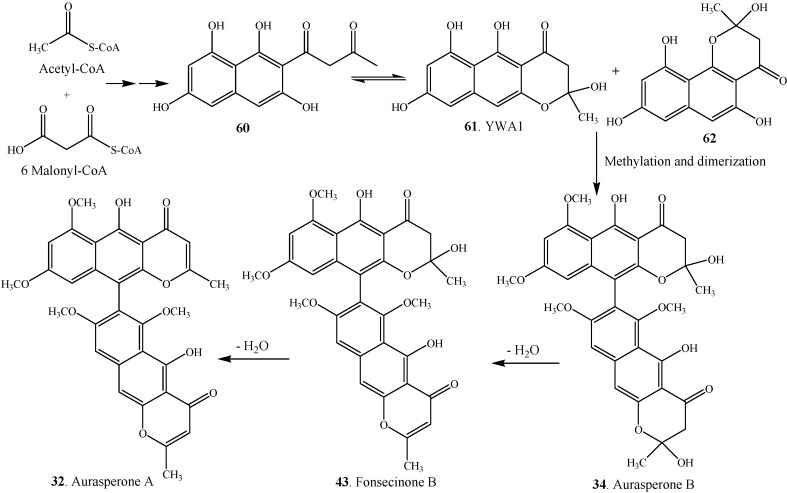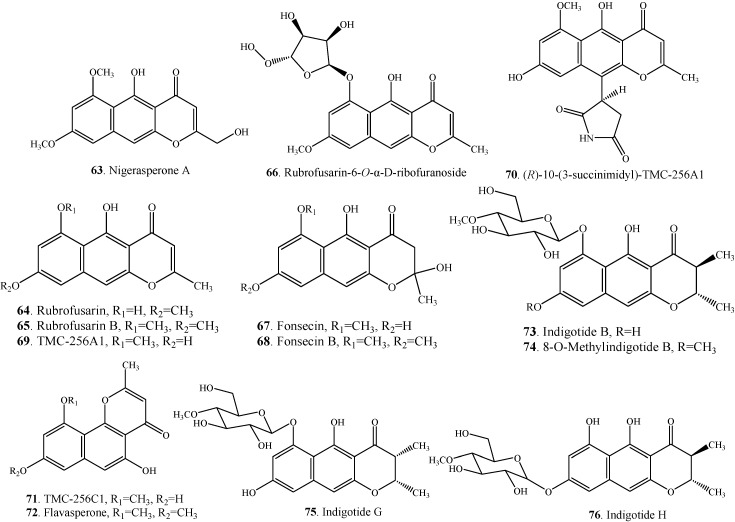Abstract
Bis-naphtho-γ-pyrones are an important group of aromatic polyketides derived from fungi. They have a variety of biological activities including cytotoxic, antitumor, antimicrobial, tyrosine kinase and HIV-1 integrase inhibition properties, demonstrating their potential applications in medicine and agriculture. At least 59 bis-naphtho-γ-pyrones from fungi have been reported in the past few decades. This mini-review aims to briefly summarize their occurrence, biosynthesis, and structure, as well as their biological activities. Some considerations regarding to synthesis, production, and medicinal and agricultural applications of bis-naphtho-γ-pyrones are also discussed.
Keywords: bis-naphtho-γ-pyrones, chaetochromin, asperpyrone, nigerone, fungi, biological activities
1. Introduction
Bis-naphtho-γ-pyrones (also known as dimeric naphtho-γ-pyrones, bis(naphtho-γ-pyrone)s, or bis-naphthopyran-4-ones) are an important group of fungal polyketides [1]. The interest of many investigators in this class of compounds is due to their broad-range biological activities with potential applications in medicine and agriculture [2,3,4]. Until now, fungal bis-naphtho-γ-pyrones and their biological activities have not been reviewed. This comprehensive mini-review describes the occurrence, biosynthesis, and biological activities of fungal bis-naphtho-γ-pyrones. We also discuss their synthesis, production and applications.
2. Occurrence
Bis-naphtho-γ-pyrones have a diverse distribution in fungi (Table 1, Table 2 and Table 3). Their structures are shown in Figure 1, Figure 2 and Figure 3. Based on the diaryl bond connection, bis-naphtho-γ-pyrones can be divided into three types (or groups), namely chaetochromin-, asperpyrone-, and nigerone-type. The absolute configurations of dimeric naphtho-γ-pyrones have been determined by circular dichroism (CD), 2D-NMR as well as X-ray diffraction analysis of some derivatives [5,6,7]. According to the literature, R-configured dimeric naphtho-γ-pyrones exhibit a first negative Cotton effect in the long-wavelength region, and a positive second one at shorter wavelength. On the contrary, S-configured dimeric naphtho-γ-pyrones exhibit a positive Cotton effect first in the long-wavelength region, and a negative one second at shorter wavelength [6,8].
Table 1.
Occurrence of chaetochromin-type bis-naphtho-γ-pyrones 1–26 in fungi.
| Bis-naphtho-γ-pyrone | Fungal Species | Reference |
|---|---|---|
| Chaetochromin A (1) | Endophytic fungus Chaetomium chiversii | [11] |
| Chaetomium gracile | [10] | |
| Chaetomium microcephalum | [12] | |
| Chaetomium virenscens (C. thielavioideum) | [13] | |
| Isochaetochromin A1 (2) | Penicillium sp. FK I-4942 | [14,15] |
| Isochaetochromin A2 (3) | Chaetomium microcephalum | [12] |
| Chaetochromin B (4) | Chaetomium gracile | [6,10] |
| Chaetomium microcephalum | [12] | |
| Isochaetochromin B1 (5) | Endophytic fungus Fusarium sp. | [3] |
| Penicillium sp. FKI-4942 | [14] | |
| Isochaetochromin B2 (6) | Endophytic fungus Fusarium sp. | [3] |
| Sponge-derived fungus Metarhizium anisopliae | [16] | |
| Penicillium sp. FKI-4942 | [14] | |
| Oxychaetochromin B (7) | Endophytic fungus Fusarium sp. | [3] |
| Chaetochromin C (8) | Chaetomium gracile | [10] |
| Chaetochromin D (9) | Chaetomium gracile | [10] |
| Isochaetochromin D1 (10) | Endophytic fungus Fusarium sp. | [3] |
| Cephalochromin = Sch 45752 (11) | Cephalosporium sp. | [17] |
| Cosmospora vilior YMJ89051501 | [18] | |
| Nectria flavoviridis | [19] | |
| Nectria viridescens | [19] | |
| Endophytic fungus Pseudoanguillospora sp. | [20] | |
| Verticillium sp. K-113 | [21] | |
| Unidentified fungal isolate SCF-125 | [22] | |
| Hypochromin A (12) | Marine-derived fungus Hypocrea vinosa | [23] |
| Hypochromin B (13) | Marine-derived fungus Hypocrea vinosa | [23] |
| SC2051 (14) | Marine-derived fungus Hypocrea vinosa | [23] |
| Ustilaginoidin A (15) | Villosiclava virens (Ustilaginoidea virens) | [24] |
| Isoustilaginoidin A (16) | Verticillium sp. K-113 | [21] |
| Dihydroisoustilaginoidin A (17) | Verticillium sp. K-113 | [21] |
| Unidentified fungal isolate SCF-125 | [22] | |
| Ustilaginoidin B (18) | Villosiclava virens (Ustilaginoidea virens) | [25] |
| Ustilaginoidin C (19) | Villosiclava virens (Ustilaginoidea virens) | [25] |
| Ustilaginoidin D (20) | Sponge-derived fungus Metarhizium anisopliae | [16] |
| Villosiclava virens (Ustilaginoidea virens) | [26] | |
| Ustilaginoidin E (21) | Villosiclava virens (Ustilaginoidea virens) | [26] |
| Ustilaginoidin F (22) | Villosiclava virens (Ustilaginoidea virens) | [26] |
| Ustilaginoidin G (23) | Villosiclava virens (Ustilaginoidea virens) | [26] |
| Ustilaginoidin H (24) | Villosiclava virens (Ustilaginoidea virens) | [26] |
| Ustilaginoidin I (25) | Villosiclava virens (Ustilaginoidea virens) | [26] |
| Ustilaginoidin J (26) | Villosiclava virens (Ustilaginoidea virens) | [26] |
Table 2.
Occurrence of asperpyrone-type bis-naphtho-γ-pyrones 27–53 in fungi.
| Bis-naphtho-γ-pyrone | Fungal Species | Reference |
|---|---|---|
| Asperpyrone A (27) | Endophytic fungus Aspergillus sp. | [34] |
| Endophytic fungus Aspergillus sp. DCS31 | [35] | |
| Aspergillus niger | [30] | |
| Endophytic fungus Aspergillus niger | [8] | |
| Endophytic fungus Aspergillus tubingensis | [36] | |
| Asperpyrone B (28) | Aspergillus niger | [30] |
| Aspergillus niger IFB-E003 | [31] | |
| Aspergillus niger ATCC 11414 | [33] | |
| Asperpyrone C (29) | Aspergillus niger | [30] |
| Asperpyrone D (30) | Endophytic fungus Aspergillus sp. DCS31 | [35] |
| Endophytic fungus Aspergillus niger | [8] | |
| Endophytic fungus Aspergillus tubingensis | [36] | |
| Asperpyrone E (31) | Endophytic fungus Aspergillus niger | [8] |
| Aurasperone A (32) | Alternaria alternata | [27] |
| Aspergillus sp. FKI-3451 | [4] | |
| Aspergillus awamori | [28,37] | |
| Endophytic fungus Aspergillus auleatus | [32] | |
| Aspergillus fonsecaeus | [29] | |
| Aspergillus niger | [28,37] | |
| Aspergillus niger | [38] | |
| Aspergillus niger | [30] | |
| Aspergillus niger IFB-E003 | [31] | |
| Aspergillus niger ATCC 11414 | [33] | |
| Endophytic fungus Aspergillus tubingensis | [36] | |
| Isoaurasperone A (33) | Endophytic fungus Aspergillus sp. | [34] |
| Aspergillus niger | [38] | |
| Endophytic fungus Aspergillus niger | [8] | |
| Aurasperone B (34) | Alternaria alternata | [27] |
| Aspergillus sp. FKI-3451 | [4] | |
| Aspergillus awamori | [28,39] | |
| Aspergillus fonsecaeus | [29] | |
| Aspergillus niger | [28,39] | |
| Aspergillus niger | [38] | |
| Aspergillus niger ATCC 11414 | [33] | |
| Aspergillus niger C-433 | [40] | |
| Aurasperone B (34) | Aspergillus niger ATCC 11414 | [33] |
| Aspergillus vadensis | [41] | |
| Aurasperone C (35) | Alternaria alternata | [27] |
| Aspergillus awamori | [28,39] | |
| Aspergillus niger | [28,39] | |
| Aspergillus niger | [38] | |
| Aspergillus niger C-433 | [40] | |
| Aspergillus niger ATCC 11414 | [33] | |
| Dianhydro-aurasperone C (36) | Endophytic fungus Aspergillus sp. | [34] |
| Aspergillus niger | [38] | |
| Endophytic fungus Aspergillus niger | [8] | |
| Endophytic fungus Aspergillus tubingensis | [36] | |
| Aurasperone D (37) | Aspergillus niger | [42] |
| Aspergillus niger | [38] | |
| Endophytic fungus Aspergillus niger | [8] | |
| Aspergillus niger C-433 | [40] | |
| Aurasperone E (38) | Aspergillus niger | [38] |
| Aspergillus niger C-433 | [40] | |
| Endophytic fungus Aspergillus tubingensis | [36] | |
| Aurasperone F (39) | Alternaria alternata | [27] |
| Aspergillus niger C-433 | [40,43] | |
| Isoaurasperone F (40) | Endophytic fungus Aspergillus niger | [8] |
| Aurasperone G (41) | Aspergillus niger C-433 | [43] |
| Fonsecinone A (42) | Endophytic fungus Aspergillus sp. | [34] |
| Endophytic fungus Aspergillus auleatus | [32] | |
| Aspergillus fonsecaeus | [29] | |
| Aspergillus niger | [30] | |
| Aspergillus niger IFB-E003 | [31] | |
| Aspergillus niger ATCC 11414 | [33] | |
| Endophytic fungus Aspergillus tubingensis | [36] | |
| Endophytic fungus Cladosporium herbarum IFB-E002 | [44] | |
| Fonsecinone B (43) | Aspergillus fonsecaeus | [29] |
| Aspergillus niger ATCC 11414 | [33] | |
| Fonsecinone C (44) | Aspergillus fonsecaeus | [29] |
| Aspergillus niger ATCC 11414 | [33] | |
| Fonsecinone D (45) | Aspergillus fonsecaeus | [29] |
| Nigerasperone B (46) | Aspergillus niger EN-13 | [45] |
| Nigerasperone C (47) | Aspergillus niger EN-13 | [45] |
| Rubasperone A (48) | Endophytic fungus Aspergillus tubingensis | [46] |
| Rubasperone B (49) | Endophytic fungus Aspergillus tubingensis | [46] |
| Rubasperone C (50) | Endophytic fungus Aspergillus tubingensis | [46] |
| Rubasperone D (51) | Endophytic fungus Aspergillus tubingensis (GX1-5E) | [47] |
| Rubasperone E (52) | Endophytic fungus Aspergillus tubingensis (GX1-5E) | [47] |
| Rubasperone F (53) | Endophytic fungus Aspergillus tubingensis (GX1-5E) | [47] |
Table 3.
Occurrence of nigerone-type bis-naphtho-γ-pyrones 54–59 in fungi.
| Bis-naphtho-γ-pyrone | Fungal Species | Reference |
|---|---|---|
| 10,10'-Bifonsecin B (54) | Marine-derived fungus Aspergillus carbonarius | [7] |
| Nigerone (55) | Marine-derived fungus Aspergillus carbonarius | [7] |
| Aspergillus niger | [5] | |
| 6'-O-Demethylnigerone (56) | Marine-derived fungus Aspergillus carbonarius | [7] |
| Aspergillus niger | [5] | |
| 8'-O-Demethylnigerone (57) | Marine-derived fungus Aspergillus carbonarius | [7] |
| 8'-O-Demethylisonigerone (58) | Marine-derived fungus Aspergillus carbonarius | [7] |
| Isonigerone (59) | Marine-derived fungus Aspergillus carbonarius | [7] |
| Aspergillus niger | [5] |
Figure 1.
Structures of chaetochromin-type bis-naphtho-γ-pyrones (1–26) from fungi.
Figure 2.
Structures of asperpyrone-type bis-naphtho-γ-pyrones (27–53) from fungi.
Figure 3.
Structures of nigerone-type bis-naphtho-γ-pyrones (54–59) from fungi.
To date, twenty-six chaetochromin-type bis-naphtho-γ-pyrones (Table 1 and Figure 1) with C-9-C-9' linkages have been isolated from the genera Chaetomium, Hypocrea, Nectria, Penicillium, Verticillium, and Villosiclava (Ustilaginoidea). The absolute configurations of ustilaginoidin A (15) and the congeners from Ustilaginoidea virens were proved to be R, and the congeners of chaetochromin A (1) from Chaetomium spp. were S [9]. Both isochaetochromins B1 (5) and B2 (6) from Fusarium sp., Penicillium sp. and Metarhizium anisopliae were considered as the diastereomers of chaetochromin B (4) [10].
Twenty-seven asperpyrone-type bis-naphtho-γ-pyrones (Table 2 and Figure 2) with C-10-C-7' or C-10-C-9' or C-6-C-7' or C-6-C-9' linkages have been isolated from the genera Alternaria and Aspergillus.
Aurasperone A (32) is a 10,7'-bisnaphtho-γ-pyrone from Alternaria alternata [27] and a few Aspergillus species [4,28,29,30,31,32,33]. This compound clearly has a positive Cotton effect first in the long wavelength region, and a negative one second at shorter wavelength, indicating positive chirality of the chromophores and the S-configuration of the compound [6]. The absolute configurations for some asperpyrone-type bis-naphtho-γ-pyrones remain to be determined.
Six nigerone-type bis-naphtho-γ-pyrones (54–59) with C-10-C-10' or C-10-C-6' linkages have been isolated from the genus Aspergillus [5,7]. All these bis-naphtho-γ-pyrones have R-configurations of the 10-10' or 10-6' bonds.
It is worth mentioning that both asperpyrone and nigerone types of bis-naphtho-γ-pyrones are produced primarily by Aspergillus species where chaetochromin-type bis-naphtho-γ-pyrones do not distribute. This indicates that bis-naphtho-γ-pyrones should have taxonomic significance which needs to be further investigated [41]. Each fungal species also needs to be clearly identified [48,49,50].
3. Biosynthesis
Chaetochromin A (1) was the first bis-naphtho-γ-pyrone whose biosynthesis was studied by employing the fungus Chaetomium gracile. Both acetate and malonate were confirmed as the precursors in the biosynthesis of chaetochromin A (1) by employing Chaetomium gracile and addition of the carbon-13 labelled precussors [51]. The proposed biosynthetic pathway (Scheme 1) of asperpyrone-type bis-naphtho-γ-pyrones in the fungus Aspergillus niger was outlined by Chiang et al. [33]. The aromatic structure of naphtho-γ-pyrones suggests that a non-reducing polyketide synthase (NR-PKS) gene with the following domain organization is likely responsible for their biosynthesis: starter unit ACP transacylase (SAT), β-ketoacyl synthase (KS), acyl transferase (AT), product template (PT), acyl carrier protein (ACP), and thiolesterase/Claisen-cyclase (TE/CLC) [33]. Linear naphtho-γ-pyrone YWA1 (61) was known in equilibrium with the side-chain open form (60). After recyclization, angular naphtho-γ-pyrone 62 could be formed in the presence of C-14 phenol group (Scheme 1). The irreversible dehydration of hemiketal from aurasperone B (34) produced stable dimeric naphtho-γ-pyrones fonsecinone B (43) and aurasperone A (32). Table 4 shows some monomeric naphtho-γ-pyrones such as rubrofusarin B (65), fonsecin (67), fonsecin B (68) and flavasperone (72) which were considered as the intermediates in the biosynthesis of bis-naphtho-γ-pyrones in fungi [38]. Accordingly, the structures of these proposed intermediates are shown in Figure 4.
Scheme 1.
Proposed biosynthetic pathway of asperpyrone-type bis-naphtho-γ-pyrones in Aspergillus niger [33].
Table 4.
Some monomeric naphtho-γ-pyrones 63–76 from fungi.
| Monomeric Naphtho-γ-pyrone | Fungal Species | Reference | |
|---|---|---|---|
| Nigerasperone A (63) | Aspergillus niger EN-13 | [45] | |
| Rubrofusarin (64) | Aspergillus niger | [38] | |
| Endophytic fungus Aspergillus tubingensis GX1-5E | [46] | ||
| Rubrofusarin B = Heminigerone (65) | Alternaria alternata | [27] | |
| Endophytic fungus Aspergillus sp. | [34] | ||
| Endophytic fungus Aspergillus niger IFB-E003 | [31] | ||
| Marine-derived fungus Aspergillus carbonarius | [7] | ||
| Aspergillus niger var. niger TC 1629 | [52] | ||
| Endophytic fungus Aspergillus tubingensis GX1-5E | [46] | ||
| Endophytic fungus Aspergillus tubingensis NRRC 4700 | [36] | ||
| Endophytic fungus Cladosporium herbarum IFB-E002 | [44] | ||
| Rubrofusarin-6-O-α-D-ribofuranoside (66) | Endophytic fungus Aspergillus niger | [8] | |
| Fonsecin (67) | Alternaria alternata | [27] | |
| Marine-derived fungus Aspergillus carbonarius | [7] | ||
| Aspergillus niger | [38] | ||
| Aspergillus niger C-433 | [40] | ||
| Aspergillus niger var.niger TC 1629 | [52] | ||
| Endophytic fungus Aspergillus tubingensis GX1-5E | [47] | ||
| Endophytic fungus Aspergillus tubingensis NRRC 4700 | [36] | ||
| Fonsecin B = Fonsecin monomethyl ether (68) | Alternaria alternata | [27] | |
| Aspergillus niger | [38] | ||
| Aspergillus niger var. niger TC 1629 | [52] | ||
| Endophytic fungus Aspergillus tubingensis NRRC 4700 | [36] | ||
| TMC-256A1 (69) | Marine-derived fungus Aspergillus carbonarius | [7] | |
| Aspergillus niger var. niger TC 1629 | [52] | ||
| Endophytic fungus Aspergillus tubingensis GX1-5E | [46] | ||
| Endophytic fungus Aspergillus tubingensis NRRC 4700 | [36] | ||
| (R)-10-(3-succinimidyl)-TMC-256A1 (70) | Endophytic fungus Aspergillus niger | [8] | |
| TMC-256C1 (71) | Aspergillus niger var. niger TC 1629 | [52] | |
| Flavasperone = Asperxanthon = TMC-256C2 (72) | Endophytic fungus Aspergillus sp. DCS31 | [35] | |
| Aspergillus sp. FKI-3451 | [4] | ||
| Marine-derived fungus Aspergillus carbonarius | [7] | ||
| Aspergillus niger | [38] | ||
| Aspergillus niger var. niger TC 1629 | [52] | ||
| Endophytic fungus Aspergillus tubingensis | [47] | ||
| Indigotide B (73) | Entomopathogenic fungus Cordyceps indigotica | [53] | |
| Sponge-derived fungus Metarhizium anisopliae mxh-99 | [16] | ||
| 8-O-Methylindigotide B (74) | Entomopathogenic fungus Cordyceps indigotica | [53] | |
| Indigotide G (75) | Sponge-derived fungus Metarhizium anisopliae mxh-99 | [16] | |
| Indigotide H (76) | Sponge-derived fungus Metarhizium anisopliae mxh-99 | [16] |
Figure 4.
Structures of some monomeric naphtho-γ-pyrones 63–76 from fungi.
4. Biological Activities
Bis-naphtho-γ-pyrones have a broad-range of biological activities such as cytotoxic, antitumor and antimicrobial properties, which are outlined in Table 5.
Table 5.
Biological activities of bis-naphtho-γ-pyrones from fungi.
| Bis-naphtho-γ-pyrone | Biological Activity | Reference |
|---|---|---|
| Chaetochromin A (1) | Cytotoxic and antitumor activity | [2,54,55] |
| Teratogenicity to mice embryo | [59] | |
| Inhibitory effects on nitric oxide (NO) production by activated macrophages | [60] | |
| Antibacterial activity | [12] | |
| Immunological activity | [12] | |
| Inhibitory activity on botulinum neurotoxin serotype A | [58] | |
| Isochaetochromin A1 (2) | Inhibitory activity on triacylglycerol synthesis | [14] |
| Isochaetochromin A2 (3) | Antibacterial activity | [12] |
| Immunological activity | [12] | |
| Chaetochromin B (4) | Cytotoxic and antitumor activity | [2,54] |
| Antibacterial activity | [12] | |
| Immunological activity | [12] | |
| Isochaetochromin B1 (5) | HIV-1 integrase inhibitory activity | [3] |
| Inhibitory activity on triacylglycerol synthesis | [14] | |
| Isochaetochromin B2 (6) | Anti-tubercular activity | [16] |
| HIV-1 integrase inhibitory activity | [3] | |
| Inhibitory activity on triacylglycerol synthesis | [14] | |
| Oxychaetochromin B (7) | HIV-1 integrase inhibitory activity | [3] |
| Chaetochromin C (8) | Cytotoxic and antitumor activity | [2,54] |
| Chaetochromin D (9) | Cytotoxic and antitumor activity | [2,54] |
| Impairing effects on mitochondrial respiration and structure | [61] | |
| Chaetochromin D1 (10) | HIV-1 integrase inhibitory activity | [3] |
| Cephalochromin (11) | Cytotoxic and antitumor activity | [18,55] |
| Inhibitory effects on nitric oxide (NO) production by activated macrophages | [57] | |
| Antimicrobial activity | [21,57] | |
| Inhibitory activity on calmodulin-sensitive cyclic nucleotide phosphodiestease | [22] | |
| Inhibitory activity on botulinum neurotoxin serotype A | [58] | |
| Hypochromin A (12) | Tyrosine kinase inhibitory activity | [23] |
| Hypochromin B (13) | Tyrosine kinase inhibitory activity | [23] |
| SC2051 (14) | Tyrosine kinase inhibitory activity | [23] |
| Ustilaginoidin A (15) | Cytotoxic and antitumor activity | [54,55] |
| Isoustilaginoidin A (16) | Antimicrobial activity | [21] |
| Dihydroisoustilaginoidin A (17) | Antimicrobial activity | [21] |
| Inhibitory effects on nitric oxide (NO) production by activated macrophages | [62] | |
| Ustilaginoidin D (20) | Cytotoxic and antitumor activity | [2] |
| Anti-tubercular activity | [16] | |
| Ustilaginoidin E (21) | Cytotoxic and antitumor activity | [2] |
| Asperpyrone A (27) | Antimicrobial activity | [34] |
| Inhibitory activity on Taq DNA polymerase | [30] | |
| Asperpyrone B (28) | Antimicrobial activity | [31] |
| Aurasperone A (32) | Antimicrobial activity | [31] |
| Inhibitory activity on xanthine oxidase | [31] | |
| Inhibitory activity on acyl-CoA:cholesterol acyltransferase | [4] | |
| Inhibitory activity on Taq DNA polymerase | [30] | |
| Isoaurasperone A (33) | Antimicrobial activity | [34] |
| Dianhydro-aurasperone C (36) | Antibacterial activity | [34] |
| Drug resistance-reversing activity | [59] | |
| Aurasperone D (37) | Central nervous system depressant effects | [42] |
| Inhibitory activity on acyl-CoA:cholesterol acyltransferase | [4] | |
| Fonscinone A (42) | Antimicrobial activity | [31,34] |
| Inhibitory activity on Taq DNA polymerase | [30] | |
| 8'-O-Demethylnigerone (57) | Anti-tubercular activity | [7] |
| 8'-O-Demethylisonigerone (58) | Anti-tubercular activity | [7] |
4.1. Cytotoxic and Antitumor Activity
Chaetochromins A (1) and D (9) from Chaetomium sp. showed strong cytotoxicity with IC50 values ranging from 0.13 to 0.24 μg/mL in cell cultures of mouse embryo limb bud (LB) and midbrain (MB). Ustilaginoidin A (15) from Ustilaginoidea virens showed relatively weak cytotoxic activity [54]. Chaetochromins A (1), B (4), C (8) and D (9) exhibited strong cytotoxicity on KB cells by inhibiting deoxyribonucleic acid, ribonucleic acid and protein biosynthesis [2]. Further mechanism of action investigations for chaetochromin A (1) revealed that the ATP synthesis in mitochondria was inhibited by uncoupling oxidative phosphorylation and depressing state-3 respiration of mitochondria, which may explain their cytotoxicity and in vivo toxicity to animals [55].
Both ustilaginoidins D (20) and E (21) exhibited strong cytotoxicity on KB cells by inhibiting biosynthesis of nucleic acid and protein [2]. Ustilaginoidin A (15) also inhibited ATP synthesis in mitochondria by uncoupling oxidative phosphorylation and depressing state-3 respiration of mitochondria [55].
Cephalochromin (11) exhibited growth-inhibitory and apoptotic activity against human lung cancer A549 cells in a dose-dependent manner with an IC50 value of 2.8 μM at 48 h. Cephalochromin induced cell cycle arrest at the G0/G1 phase through down-regulation of cyclin D1, cyclin E, Cdk 2, and Cdk 4 expressions. It markedly increased the hypodiploid sub-G1 phase (apoptosis) of the cell cycle at 48 h as measured by flow cytometric analysis. Reactive oxygen species generation and loss of the mitochondrial membrane potential (MMP) were also markedly induced by cephalochromin [18]. Cephalochromin (11) also inhibited ATP synthesis in mitochondria by uncoupling oxidative phosphorylation and depressing state-3 respiration of mitochondria [55].
4.2. Antimicrobial Activity
Isochaetochromin B2 (6) and ustilaginoidin D (20) isolated from the sponge-derived fungus Metarhizium anisopliae mxh-99 exhibited anti-tubercular activity with MIC values of 50.0 μg/mL [16]. 8'-O-Demethylnigerone (57) and 8'-O-demethylisonigerone (58) from the marine-derived Aspergillus carbonarius also showed weak anti-tubercular activity against Mycobacterium tuberculosis H37Rv with MIC values of 43.0 and 21.5 μM, respectively [7].
Cephalochromin (11), isoustilaginoidin A (16), and dihydroisoustilaginoidin A (17) isolated from Verticillium sp. K-113 were active against Gram-positive bacteria (Bacillus subtilis, Staphylococcus aureus, and Streptococcus pyogenes) with MIC values ranging from 3 to 10 μg/mL, but not against Gram-negative bacteria and fungi [21]. Chaetochromin A (1), isochaetochromin A2 (3), and chaetochromin B (4) possessed significant antibacterial activity against Escherichia coli, Staphylococcus aureus and Bacillus subtilis [12]. Asperpyrone B (28), aurasperone A (32) and fonscinone A (42) isolated from the endophytic fungus Aspergillus niger IFB-E003 exhibited growth inhibition against bacteria (Bacilllus subtilis, Escherichia coli and Pseudomonas fluorescence) and fungi (Trichophyton rubrum and Candida albicans) with MIC values ranging from 1.9 to 31.2 μg/mL [31].
Asperpyrone A (27), isoaurasperone A (33), dianhydroaurasperone C (36), and fonsecinone A (42) from an endophytic Aspergillus species showed antimicrobial activities. Among them, fonsecinone A (42) exhibited the strongest antifungal and antibacterial activity, with MIC values of 12.5 and 25 μM, respectively [34].
Bacterial enoyl-acyl carrier protein reductase (FabI) in bacterial fatty acid synthesis has been demonstrated to be an antibacterial target [56]. Cephalochromin (11) inhibited FabI of Staphylococcus aureus and Escherichia coli with IC50 values of 1.9 and 1.8 μM, respectively [57].
4.3. Other Biological Activities
In addition to the cytotoxic, antitumor and antimicrobial activities of bis-nathphtho-γ-pyrones mentioned above, other biological activities include tyrosine kinase inhibition [23], HIV-1 integrase inhibition [3], calmodulin-sensitive cycle nucleotide phosphodiestease inhibition [22], triacylglycerol synthesis inhibition [14], xanthine oxidase inhibition [31], acyl-CoA:cholesterol acyltransferase inhibition [4], central nerveous system depressant effects [42], immunological activity [12], botulinum neutotoxin serotype A inhibition [57], drug resistance-reversing activity [58], and Taq DNA polymerase inhibition [30], which are outlined in Table 5.
5. Conclusions and Future Perspectives
About 59 fungal bis-naphtho-γ-pyrones have been investigated in the past few decades. Some of them display diverse bioactivities, especially cytotoxic, antitumor and antimicrobial activities. The remaining bis-naphtho-γ-pyrones produced by fungi and their bioactivities need to be further studied. In recent years, an increasing number of bis-naphtho-γ-pyrones have been isolated from endophytic fungi [3,10,20] and marine-derived fungi [7,16,23]. These fungi could be the rich sources of biologically active metabolites that are indispensable for medicinal and agricultural applications [1,63,64,65,66]. In most cases, biological activities, structure-activity relationships, and mode of action of bis-naphtho-γ-pyrones have been only primarily investigated and need to be studied in detail. The potential applications of bis-naphtho-γ-pyrones as antitumor agents, antimicrobials, and antivirus agents as well as their promising bioactivities have led to considerable interest within the pharmaceutical community. Chemical syntheses have been achieved for a few bioactive bis-naphtho-γ-pyrones such as ustilaginoidin A (15) [67] and nigerone (55) [68,69]. After comprehensive understanding of biosynthetic pathways of some bis-naphtho-γ-pyrones in the next few years, we can effectively not only increase yields of the bioactive bis-naphtho-γ-pyrones (i.e., cephalochromin, isochaetochromins B1 and B2), but also prevent biosynthesis of some toxic bis-naphtho-γ-pyrones (i.e., ustilaginoidins A–J) [70]. In addition, the physiological and ecological roles of the bis-naphtho-γ-pyrones in fungi need to be clarified in detail [71,72].
Acknowledgments
This work was co-financed by the grants from the National Basic Research Program of China (2013GB127800), the Hi-Tech R&D Program of China (2011AA10A202), the Special Fund for Agro-Scientific Research in the Public Interest of China (200903039-6), and the National Natural Science Foundation of China (31271996).
Author Contributions
Shiqiong Lu performed bibliographic researches, drafted and corrected manuscript. Jin Tian, Weibo Sun, Jiajia Meng, Xiaohan Wang, Xiaoxiang Fu and Ali Wang participated in the discussions and supported manuscript corrections. Daowan Lai reviewed manuscript and helped to revised it. Yang Liu and Ligang Zhou conceived the idea, designed review structure, supervised manuscript drafting, and revised manuscript. All authors read and approved the final manuscript.
Conflicts of Interest
The authors declare no conflict of interest.
References
- 1.Nielsen K.F., Mogensen J.M., Johansen M., Larsen T.O., Frisvad J.C. Review of secondary metabolites and mycotoxins from the Aspergillus niger group. Anal. Bioanal. Chem. 2009;395:1225–1242. doi: 10.1007/s00216-009-3081-5. [DOI] [PubMed] [Google Scholar]
- 2.Koyama K., Ominato K., Natori S., Tashiro T., Tsuruo T. Cytotoxicity and antitumor activities of fungal bis(naphtho-γ-pyrone) derivatives. J. Pharmacobiodyn. 1988;11:630–635. doi: 10.1248/bpb1978.11.630. [DOI] [PubMed] [Google Scholar]
- 3.Singh S.B., Zink D.L., Bills G.F., Teran A., Silverman K.C., Lingham R.B., Felock P., Hazuda D. Four novel bis-(naphtho-γ-pyrones) isolated from Fusarium species as inhibitors of HIV-1 integrase. Bioorg. Med. Chem. Lett. 2003;13:713–717. doi: 10.1016/S0960-894X(02)01057-0. [DOI] [PubMed] [Google Scholar]
- 4.Sakai K., Ohte S., Ohshiro T., Matsuda D., Masuma R., Rudel L.L., Tomoda H. Selective inhibition of Acyl-CoA:Cholesterol acyltransferase 2 isozyme by flavasperone and sterigmatocystin from Aspergillus species. J. Antibiot. 2008;61:568–572. doi: 10.1038/ja.2008.76. [DOI] [PubMed] [Google Scholar]
- 5.Gorst-Allman C.P., Steyn P.S., Rabie C.J. Structural elucidation of the nigerones, four new naphthopyrones from cultures of Aspergillus niger. J. Chem. Soc. Perkin Trans. 1. 1980;1980:2474–2479. doi: 10.1039/p19800002474. [DOI] [Google Scholar]
- 6.Koyama K., Natori S., Iitaka Y. Absolute configurations of chaetochromin A and related bis(naphtho-γ-pyrone) mold metabolites. Chem. Pharm. Bull. 1987;35:4049–4055. doi: 10.1248/cpb.35.4049. [DOI] [Google Scholar]
- 7.Zhang Y., Ling S., Fang Y., Zhu T., Gu Q., Zhu W.-M. Isolation, structure elucidation, and antimycobacterial properties of dimeric naphtho-γ-pyrones from the marine-derived fungus Aspergillus carbonarius. Chem. Biodivers. 2008;5:93–100. doi: 10.1002/cbdv.200890017. [DOI] [PubMed] [Google Scholar]
- 8.Li X.-B., Xie F., Liu S.-S., Li Y., Zhou J.-C., Liu Y.-Q., Yuan H.-Q., Lou H.-X. Naphtho-γ-pyrones from endophyte Aspergillus niger occurring in the liverwort Heteroscyphus tener (Steph.) Schiffn. Chem. Biodivers. 2013;10:1193–1201. doi: 10.1002/cbdv.201300042. [DOI] [PubMed] [Google Scholar]
- 9.Koyama K., Aida S., Natori S. Supplemental observations on atropisomerism of fungal bis(naphtho-γ-pyrone)s. Chem. Pharm. Bull. 1990;38:2259–2261. doi: 10.1248/cpb.38.2259. [DOI] [Google Scholar]
- 10.Koyama K., Natori S. Chaetochromins B, C and D, bis(naphtho-γ-pyrone) derivatives from Chaetomium gracile. Chem. Pharm. Bull. 1987;35:578–584. doi: 10.1248/cpb.35.578. [DOI] [PubMed] [Google Scholar]
- 11.Paranagama P.A., Wijeratne E.M.K., Gunatilaka A.A.L. Uncovering biosynthetic potential of plant-associated fungi: Effect of culture conditions on metabolite production by Paraphaeosphaeria quadriseptata and Chaetomium chiversii. J. Nat. Prod. 2007;70:1939–1945. doi: 10.1021/np070504b. [DOI] [PubMed] [Google Scholar]
- 12.Xu G.-B., Yang T., Bao J.-K., Fang D.-M., Li G.-Y. Isochaetochromin A2, a new bis(naphthodihydropyran-4-one) with antimicrobial and immunological activities from fungus Chaetomium microcephalum. Arch. Pharm. Res. 2014;37:575–579. doi: 10.1007/s12272-013-0206-3. [DOI] [PubMed] [Google Scholar]
- 13.Sekita S., Yoshihira K., Natori S. Chaetochromin, a bis(naphthodihydropyran-4-one) mycotoxin from Chaetomium thielavioideum: Application of 13C-1H long-range coupling to the structure elucidation. Chem. Pharm. Bull. 1980;28:2428–2435. doi: 10.1248/cpb.28.2428. [DOI] [Google Scholar]
- 14.Ugaki N., Matsuda D., Yamazaki H., Nonaka K., Masuma R., Omura S., Tomoda H. New isochaetochromin, an inhibitor of triacylalycerol synthesis in mammalian cells, produced by Penicillium sp. FKI-4942: I. Taxonomy, fermentation, isolation and biological properties. J. Antibiot. 2012;65:15–19. doi: 10.1038/ja.2011.105. [DOI] [PubMed] [Google Scholar]
- 15.Ugaki N., Yamazaki H., Uchida R., Tomoda H. New isochaetochromin, an inhibitor of triacylglycerol synthesis in mammalian cells, produced by Penicillium sp. FKI-4942: II. Structure elucidation. J. Antibiot. 2012;65:21–24. doi: 10.1038/ja.2011.106. [DOI] [PubMed] [Google Scholar]
- 16.Kong X., Ma X., Xie Y., Cai S., Zhu T., Gu Q., Li D. Aromatic polyketides from a sponge-derived fungus Metarhizium anisopliae mxh-99 and their antitubercular activities. Arch. Pharm. Res. 2013;36:739–744. doi: 10.1007/s12272-013-0077-7. [DOI] [PubMed] [Google Scholar]
- 17.Haskins R.H., Knapp C. Cephalosporium species (PRL 2070) and the production of cephalochromin. Can. J. Microbiol. 1969;15:435–437. doi: 10.1139/m69-076. [DOI] [PubMed] [Google Scholar]
- 18.Hsiao C.-J., Hsiao G., Chen W.-L., Wang S.-W., Chiang C.-P., Liu L.-Y., Guh J.-H., Lee T.-H., Chung C.-L. Cephalochromin induces G0/G1 cell cycle arrest and apoptosis in A549 human non-small-cell lung cancer cells by inflicting mitochondrial disruption. J. Nat. Prod. 2014;77:758–765. doi: 10.1021/np400517g. [DOI] [PubMed] [Google Scholar]
- 19.Carey S.T., Nair M.S.R. Metabolites of Pyrenomycetes. V. identification of an antibiotic from two species of Nectria, as cephalochromin. Lloydia. 1975;38:448–449. [PubMed] [Google Scholar]
- 20.Kock I., Draeger S., Schulz B., Elsasser B., Kurtan T., Kenez A., Antus S., Pescitelli G., Salvadori P., Speakman J.-B., et al. Pseudoanguillosporin A and B: Two new isochromans isolated from the endophytic fungus Pseudoanguillospora sp. Eur. J. Org. Chem. 2009;2009:1427–1434. doi: 10.1002/ejoc.200801083. [DOI] [Google Scholar]
- 21.Matsumoto M., Minato H., Kondo E., Mitsugi T., Katagiri K. Cephalochromin, dihydroisoustilaginoidin A, and isoustilaginoidin A from Verticillium sp. K-113. J. Antibiot. 1975;28:602–604. doi: 10.7164/antibiotics.28.602. [DOI] [PubMed] [Google Scholar]
- 22.Hegde V.R., Miller J.R., Patel M.G., King A.H., Puar M.S., Horan A., Hart R., Yarborough R., Gullo V. Sch 45752—An inhibitor of calmodulin-sensitive cyclic nucleotide phosphodiesterase activities. J. Antibiot. 1993;46:207–213. doi: 10.7164/antibiotics.46.207. [DOI] [PubMed] [Google Scholar]
- 23.Ohkawa Y., Miki K., Suzuki T., Nishio K., Sugita T., Kinoshita K., Takhashi K., Koyama K. Antiangiogenic metabolites from a marine-derived fungus, Hypocrea vinosa. J. Nat. Prod. 2010;73:579–582. doi: 10.1021/np900698p. [DOI] [PubMed] [Google Scholar]
- 24.Shibata S., Ogihara Y., Ohta A. Metabolic products of fungi. XXII. On ustilaginoidins. 2. The structure of ustilaginoidin A. Chem. Pharm. Bull. 1963;11:1179–1182. doi: 10.1248/cpb.11.1179. [DOI] [PubMed] [Google Scholar]
- 25.Shibata S., Ogihara Y. Metabolic products of fungi. XXIII. Ustilaginoidins. 3. The structure of ustilaginoidins B and C. Chem. Pharm. Bull. 1963;11:1576–1578. doi: 10.1248/cpb.11.1576. [DOI] [PubMed] [Google Scholar]
- 26.Koyama K., Natori S. Further characterization of seven bis(naphtho-γ-pyrone) congeners of ustilaginoidins, coloring matters of Claviceps virens (Ustilaginoidea virens) Chem. Pharm. Bull. 1988;36:146–152. doi: 10.1248/cpb.36.146. [DOI] [Google Scholar]
- 27.Shaaban M., Shaaban K.A., Abdel-Aziz M.S. Seven naphtho-γ-pyrones from the marine derived fungus Alternaria alternata: Structure elucidation and biological properties. Org. Med. Chem. Lett. 2012;2:6. doi: 10.1186/2191-2858-2-6. [DOI] [PMC free article] [PubMed] [Google Scholar]
- 28.Tanaka H., Wang P.-L., Yamada O., Tamura L.T. Yellow pigments of Aspergillus niger and Aspergillus awamori. Part I. Isolation of aurasperone A and related pigments. Agric. Biol. Chem. 1966;30:107–113. doi: 10.1271/bbb1961.30.107. [DOI] [Google Scholar]
- 29.Priestap H.A. New naphthopyrones from Aspergillus fonsecaeus. Tetrahedron. 1984;40:3617–3624. doi: 10.1016/S0040-4020(01)88792-5. [DOI] [Google Scholar]
- 30.Akiyama K., Teraguchi S., Hamasaki Y., Mori M., Tatsumi K., Ohnishi K., Hayashi H. New dimeric naphthopyrones from Aspergillus niger. J. Nat. Prod. 2003;66:136–139. doi: 10.1021/np020174p. [DOI] [PubMed] [Google Scholar]
- 31.Song Y.C., Li H., Ye Y.H., Shan C.Y., Yang Y.M., Tan R.X. Endophytic naphthopyrone metabolites are co-inhibitors of xanthine oxidase, SW1116 cell and some microbial growths. FEMS Microbiol. Lett. 2004;241:67–72. doi: 10.1016/j.femsle.2004.10.005. [DOI] [PubMed] [Google Scholar]
- 32.Campos F.R., Barison A., Daolio C., Ferreira A.G., Rodrigues-Fo E. Complete 1H- and 13C-NMR assignments of aurasperone A and fonsecinone A, two bis-naphthopyrones produced by Aspergillus aculeatus. Magn. Reson. Chem. 2005;43:962–965. doi: 10.1002/mrc.1654. [DOI] [PubMed] [Google Scholar]
- 33.Chiang Y.-M., Meyer K.M., Praseuth M., Baker S.E., Bruno K.S., Wang C.C.C. Characterization of a polyketide synthase in Aspergillus niger whose product is a precursor for both dihydroxynaphthalene (DHN) melanin and naphtho-γ-pyrone. Fungal Genet. Biol. 2011;48:430–437. doi: 10.1016/j.fgb.2010.12.001. [DOI] [PMC free article] [PubMed] [Google Scholar]
- 34.Xiao J., Zhang Q., Gao Y.-Q., Shi X.-W., Gao J.-M. Antifungal and antibacterial metabolites from an endophytic Aspergillus sp. associated with Melia azedarach. Nat. Prod. Res. 2014;28 doi: 10.1080/14786419.2014.904308. [DOI] [PubMed] [Google Scholar]
- 35.Meng X., Ge F., Zeng Y., Zhao P. Chemical constituents from the endophytic fungus Aspergillus sp. DCS31 of Daphniphyllum longeracemosum. Nat. Prod. Res. Dev. 2013;25:190–192. [Google Scholar]
- 36.Zhan J., Gunaherath G.M.K.B., Wijeratne E.M.K., Gunatilaka A.A.L. Asperpyrone D and other metabolites of the plant-associated fungal strain Aspergillus tubingensis. Phytochemistry. 2007;68:368–372. doi: 10.1016/j.phytochem.2006.09.038. [DOI] [PMC free article] [PubMed] [Google Scholar]
- 37.Wang P.-L., Tanaka H. Yellow pigments of Aspergillus niger and Aperigillus awamori. Part II. Chemical structure of aurasperone A. Agric. Biol. Chem. 1966;30:683–687. doi: 10.1271/bbb1961.30.683. [DOI] [Google Scholar]
- 38.Ehrlich K.C., DeLucca A.J, Ciegler A. Naphtho-γ-pyrone production by Aspergillus niger isolated from stored cottonseed. Appl. Environ. Microbiol. 1984;48:1–4. doi: 10.1128/aem.48.1.1-4.1984. [DOI] [PMC free article] [PubMed] [Google Scholar]
- 39.Tanaka H., Wang P.-L., Namiki M. Structure of aurasperone C. Agric. Biol. Chem. 1972;36:2511–2517. doi: 10.1271/bbb1961.36.2511. [DOI] [Google Scholar]
- 40.Bouras N., Mathieu F., Coppel Y., Lebrihi A. Aurasperone F—A new member of the naphtho-gamma-pyrone class isolated from a cultured microfungus, Aspergillus niger C-433. Nat. Prod. Res. 2005;19:653–659. doi: 10.1080/14786410412331286955. [DOI] [PubMed] [Google Scholar]
- 41.De Vries R.P., Frisvad J.C., van de Vondervoort P.J.I., Burgers K., Kuijpers A.F.A., Samson R.A., Visser J. Aspergillus vadensis, a new species of the group of black Aspergilli. Antonie Van Leeuwenkoek. 2005;87:195–203. doi: 10.1007/s10482-004-3194-y. [DOI] [PubMed] [Google Scholar]
- 42.Ghosal S., Biswas K., Chakrabarti D.K. Toxic naphtho-γ-pyrones from Aspergillus niger. J. Agric. Food. Chem. 1979;27:1347–1351. doi: 10.1021/jf60226a018. [DOI] [PubMed] [Google Scholar]
- 43.Bouras N., Mathieu F., Coppel Y., Strelkov S.E., Lebrihi A. Occurrence of naphtho-gamma-pyrones- and ochratoxin A—Producing fungi in French grapes and characterization of new naphtho-gamma-pyrone polyketide (aurasperone G) isolated from Aspergillus niger C-433. J. Agric. Food Chem. 2007;55:8920–8927. doi: 10.1021/jf071406z. [DOI] [PubMed] [Google Scholar]
- 44.Ye Y.H., Zhu H.L., Song Y.C., Liu S.J., Tan R.X. Structural revision of aspernigrin A, reisolated from Cladosporium herbarum IFB-E002. J. Nat. Prod. 2005;68:1106–1108. doi: 10.1021/np050059p. [DOI] [PubMed] [Google Scholar]
- 45.Zhang Y., Li X.-M., Wang B.-G. Nigerasperones A-C, new monomeric and dimeric naphtho-γ-pyrones from marine alga-derived endophytic fungus Aspergillus niger EN-13. J. Antibiot. 2007;60:204–210. doi: 10.1038/ja.2007.24. [DOI] [PubMed] [Google Scholar]
- 46.Huang H.-B., Feng X.-J., Liu L., Chen B., Lu Y.-J., Ma L., She Z.-G., Lin Y.-C. Three dimeric naphtho-γ-pyrones from the mangrove endophytic fungus Aspergillus tubingensis isolated from Pongamia pinnata. Planta Med. 2010;76:1888–1891. doi: 10.1055/s-0030-1249955. [DOI] [PubMed] [Google Scholar]
- 47.Huang H.-B., Xiao Z.-E., Feng X.-J., Huang C.-H., Zhu X., Ju J.-H., Li M.-F., Lin Y.-C., Liu L., She Z.-G. Cytotoxic naphtho-γ-pyrones from the mangrove endophytic fungus Aspergillus tubingensis (GX1–5E) Helv. Chim. Acta. 2011;94:1732–1740. doi: 10.1002/hlca.201100050. [DOI] [Google Scholar]
- 48.Geiser D.M., Klich M.A., Frisvad J.C., Peterson S.W., Varga J., Samson R.A. The current status of species recognition and identification in Aspergillus. Stud. Mycol. 2007;59:1–10. doi: 10.3114/sim.2007.59.01. [DOI] [PMC free article] [PubMed] [Google Scholar]
- 49.Perrone G., Susca A., Cozzi G., Ehrlich K., Varga J., Frisvad J.C., Meijer M., Noonim P., Mahakarnchanakul W., Samson R.A. Biodiversity of Aspergillus species in some important agricultural products. Stud. Mycol. 2007;59:53–66. doi: 10.3114/sim.2007.59.07. [DOI] [PMC free article] [PubMed] [Google Scholar]
- 50.Samson R.A., Varga J. What is a species in Aspergillus? Med. Mycol. 2009;47:S13–S20. doi: 10.1080/13693780802354011. [DOI] [PubMed] [Google Scholar]
- 51.Koyama K., Natori S. Biosynthesis of chaetochromin A, a bis(naphtho-γ-pyrone), in Chaetomium spp. Chem. Pharm. Bull. 1989;37:2022–2025. doi: 10.1248/cpb.37.2022. [DOI] [PubMed] [Google Scholar]
- 52.Sakurai M., Kohno J., Yamamoto K., Okuda T., Nishio M., Kawano K., Ohnuki T. TMC-256A1 and C1, new inhibitors of IL-4 signal transduction produced by Aspergillus niger var. niger TC 1629. J. Antibiot. 2002;55:685–692. doi: 10.7164/antibiotics.55.685. [DOI] [PubMed] [Google Scholar]
- 53.Asai T., Yamamoto T., Oshima Y. Aromatic polyketide production in Cordyceps indigotica, an entomopathogenic fungus, induced by exposure to a histone deacetylase inhibitor. Org. Lett. 2012;14:2006–2009. doi: 10.1021/ol3005062. [DOI] [PubMed] [Google Scholar]
- 54.Tsuchiya T., Sekita S., Koyama K., Natori S., Takahashi A. Effect of chaetochromin A, chaetochromin D and ustilaginoidin A, bisnaphtho-γ-pyrone derivatives, on the mouse embryo limb bud and midbrain cells in culture. Cong. Anom. 1987;27:245–250. doi: 10.1111/j.1741-4520.1987.tb00707.x. [DOI] [Google Scholar]
- 55.Kawai K., Hisada K., Mori S., Nozawa Y., Koyama K., Natori S. The impairing effect of chaetochromin A and related mycotoxins on mitochondrial respiration. Proc. Jpn. Assoc. Mycotoxicol. 1991;33:31–35. [Google Scholar]
- 56.Campbell J.W., Cronan J.E. Bacterial fatty acid biosynthesis: Targets for antibacterial drug discovery. Annu. Rev. Microbiol. 2001;55:305–332. doi: 10.1146/annurev.micro.55.1.305. [DOI] [PubMed] [Google Scholar]
- 57.Zheng C.J., Sohn M.-J., Lee S., Hong Y.-S., Kwak J.-H., Kim W.-G. Cephalochromin, a FabI-directed antibacterial of microbial origin. Biochem. Biophys. Res. Commun. 2007;362:1107–1112. doi: 10.1016/j.bbrc.2007.08.144. [DOI] [PubMed] [Google Scholar]
- 58.Cardellina J.H., Roxas-Duncan V.I., Montgomery V., Eccard V., Campbell Y., Hu X., Khavrutskii I., Tawa G.J., Wallqvist A., Gloer J.B., et al. Fungal bis-naphthopyrones as inhibitors of botulinum neurotoxin serotype A. ACS Med. Chem. Lett. 2012;3:387–391. doi: 10.1021/ml200312s. [DOI] [PMC free article] [PubMed] [Google Scholar]
- 59.Ikeda S.-I., Sugita M., Yoshimura A., Sumizawa T., Douzono H., Nagata Y., Akiyama S.-I. Aspergillus species strain M39 produces two naphtho-γ-pyrones that reverse drug resistance in human KB cells. Int. J. Cancer. 1990;45:508–513. doi: 10.1002/ijc.2910450323. [DOI] [PubMed] [Google Scholar]
- 60.Ito Y., Ohtsubo K. Teratogenicity of oral chaetochromin, a polyphenolic mycotoxin produced by Chaetomium spp., to mice embryo. Bull. Environ. Contam. Toxicol. 1987;39:299–303. doi: 10.1007/BF01689421. [DOI] [PubMed] [Google Scholar]
- 61.Mori S., Kawai K., Nozawa Y., Koyama K., Natori S. The impairing effects of chaetochromin D on mitochondrial respiration and structure. Mycotoxin Res. 1993;9:85–93. doi: 10.1007/BF03192239. [DOI] [PubMed] [Google Scholar]
- 62.Ishii R., Horie M., Koyama K., Ishikawa Y., Kitanaka S. Inhibitory effects of fungal bis(naphtho-γ-pyrone) derivatives on nitric oxide production by a murine macrophage-like cell line, RAW 264.7, activated by lipopolysaccharide and interferon-γ. Biol. Pharm. Bull. 2005;28:786–790. doi: 10.1248/bpb.28.786. [DOI] [PubMed] [Google Scholar]
- 63.Zhao J., Shan T., Mou Y., Zhou L. Plant-derived bioactive compounds produced by endophytic fungi. Mini Rev. Med. Chem. 2011;11:159–168. doi: 10.2174/138955711794519492. [DOI] [PubMed] [Google Scholar]
- 64.Gutierrez R.M.P., Gonzalez A.M.N., Ramirez A.M. Compounds derived from endophytes: A review of phytochemistry and pharmacology. Curr. Med. Chem. 2012;19:2992–3030. doi: 10.2174/092986712800672111. [DOI] [PubMed] [Google Scholar]
- 65.Debbab A., Aly A.H., Proksch P. Mangrove derived fungal endophytes—A chemical and biological perception. Fungal Divers. 2013;61:1–27. doi: 10.1007/s13225-013-0243-8. [DOI] [Google Scholar]
- 66.Lee Y.M., Kim M.J., Li H., Zhang P., Bao B, Lee K.J., Jung J.H. Marine-derived Aspergillus species as a source of bioactive secondary metabolites. Mar. Biotechnol. 2013;15:499–519. doi: 10.1007/s10126-013-9506-3. [DOI] [PubMed] [Google Scholar]
- 67.Morishita E., Shibatam S. Metabolic products of fungi. XXVII. Synthesis of racemic unstilaginoidin A and its related compounds. Chem. Pharm. Bull. 1967;15:1772–1775. doi: 10.1248/cpb.15.1772. [DOI] [PubMed] [Google Scholar]
- 68.DiVirgilio E.S., Dugan E.C., Mulrooney C.A., Kozlowski M.C. Asymmetric total synthesis of nigerone. Org. Lett. 2007;9:385–388. doi: 10.1021/ol062468y. [DOI] [PubMed] [Google Scholar]
- 69.Kozlowski M.C., Dugan E.C., DiVirgilio E.S., Maksimenka K., Bringmann G. Asymmetric total synthesis of nigerone and ent-nigerone: Enantioselective oxidative biaryl coupling highly hindered naphthols. Adv. Synth. Catal. 2007;349:583–594. doi: 10.1002/adsc.200600570. [DOI] [Google Scholar]
- 70.Marin P., de Ory A., Cruz A., Magan N., Gonzalez-Jaen M.T. Potential effects of environmental conditions on the efficiency of the antifungal tebuconazole controlling Fusarium verticillioides and Fusarium proliferatum growth rate and fumonisin biosynthesis. Int. J. Food Microbiol. 2013;165:251–258. doi: 10.1016/j.ijfoodmicro.2013.05.022. [DOI] [PubMed] [Google Scholar]
- 71.Jorgensen T.R., Park J., Arentshorst M., van Welzen A.M., Lamers G., van Kuyk P.A., Damveld R.A., van den Hondel C.A.M., Nielsen K.F., Frisvad J.C., et al. The molecular and genetic basis of conidial pigmentation in Aspergillus niger. Fungal Genet. Biol. 2011;48:544–553. doi: 10.1016/j.fgb.2011.01.005. [DOI] [PubMed] [Google Scholar]
- 72.Zhou L., Lu S., Shan T., Wang P., Sun W., Chen Z., Wang S. Chemistry and biology of mycotoxins from rice false smut pathogen. In: Melborn B.J., Greene J.C., editors. Mycotoxins: Properties, Applications and Hazards. Nova Science Publishers; New York, NY, USA: 2012. pp. 109–130. [Google Scholar]



